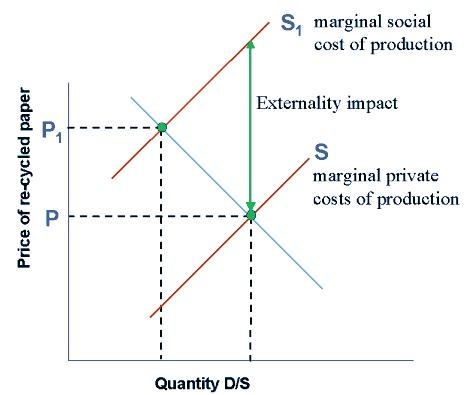| Green Economics - The basics |
|
Externalities and Real Markets |

|
|
Certainly the example shown in figure 2 is idealised, however markets do find equilibrium positions and economic theory demonstrates that markets can achieve efficient allocation of resources provided that "externalities" are not present. However in the real world "externalities" do exist, and markets fail the efficiency test, pollution for example is an "externality", its existence affects the fourth structural condition, i.e. that the full costs of production and consumption be reflected in the market place. Figure 3 illustrates the case of a re-cycled paper production plant the point P indicates the "natural" equilibrium position, i.e. without any government controls, e.g. legislation, regulations or taxes on pollution. However re-cycling paper although producing an "environmentally" friendly product, also produces potentially damaging liquid wastes. If the plant were to discharge this directly into a nearby river, other industrial water users further downstream might be required to treat the water before using it, local wildlife might be damaged and recreational uses might be curtailed. |
 Figure 3
Figure 3
|
|
Thus the full cost of producing and consuming the re-cycled paper is not reflected properly. If these social costs were "internalised" then the supply line moves to S1 and a new equilibrium position is found in which costs and prices are higher to reflect the waste assimilation service of the environment. Correcting for externalities in practice requires government intervention, i.e. economic instruments in the form of fines, taxes etc. In reality there are guidelines and legislation controlling discharges to water. In order to internalise the environmental costs requires the ability to cost issues surrounding the loss of wildlife and amenity etc. The question of how this can be done and how free markets can support the true balance is the subject of much debate and development in the field of "green" economics. |
| Task 3. Consider your own business and/or an alternative industry, identify some of the externalities, i.e. issues that affect the structural requirements for competition, concentrate on environmental impacts. Review the internal and external costs within your own business and summarise the issues you would face if these external costs were to be wholly attributed to your products or service. |